Potato Cakes Recipe
If you have leftover mashed potatoes and a few staple ingredients, you can make these crispy-on-the-outside and creamy-on-the-inside Potato Cakes that are great for any meal of the day.
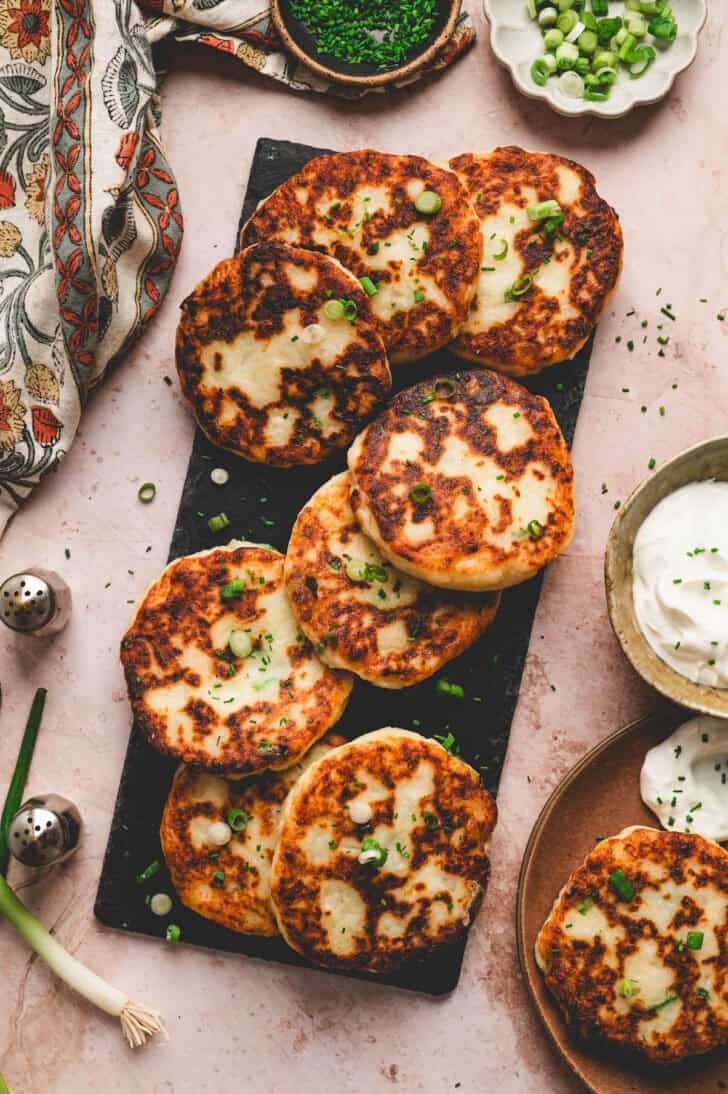
Potato Cakes From Mashed Potatoes Are The Best Way To Use Leftovers
The thing about three person families is that we ALWAYS have leftovers. With my husband and I both having grown up in three person families, and now having a three person family of our own, we know this to be a fact a life.
And when mashed potatoes are involved? Forget it. It’s impossible to make mashed potatoes for three people. We will always have leftovers, and we now know to always be prepared for that.
Often, we’ll repurpose them into a loaded Mashed Potato Casserole (with over a half million page views, it’s popular around here!), but sometimes we don’t necessarily want something with cheddar cheese and bacon.
So today, we’re sharing a recipe for repurposing leftover mashed potatoes into crispy-on-the-outside, creamy-on-the-inside potato pancakes, using just a handful of ingredients.. This potato cake recipe is similar to a dish my mom used to make for the three of us, and now I make these for my family, too!
Why You’ll Love This Potato Cake Recipe
- They’re equally great for breakfast, lunch or dinner.
- They come together with just a few ingredients that we consider pantry and fridge staples. Don’t have the chives or green onions? Skip them, it’ll be totally fine.
- They freeze really well, making it a good way to save leftovers for future meals.

Potato Cake Ingredients
A full recipe card, including exact ingredient amounts, appears at the bottom of this post.
- chilled leftover mashed potatoes – we’ll be using them straight from the fridge, no need to reheat them first. These work best with homemade mashed potatoes (not instant).
- egg – you’ll need one egg for this recipe for potato cakes, which will act as a binder and help the cakes stay together.
- garlic – we love this for added flavor, unless of course your leftover mashed potatoes already contain garlic!
- flour – we like a thin dusting of flour on the outside of the mashed potato cakes to help them brown, and you may or may not need some flour in the potato cake mixture itself, depending on the consistency of your mashed potatoes. More on that later!
- Parmesan cheese – we like the salty, earthy flavor that Parmesan adds to this recipe. We’ve tested this recipe with both shredded and grated Parmesan, and we prefer grated, but shredded works if it’s what you have.
- chives – or green onions work, too! Skip this if you don’t have either.
- vegetable oil – you’ll need this for pan frying the potato cakes. Olive oil also works, or you could use nonstick spray if you wanted to use a little less oil.
Make This Potato Cakes Recipe With Any Type Of Leftover Mashed Potatoes
You certainly don’t have to start with just plain Russet Mashed Potatoes to make these leftover mashed potato cakes (although you can really never go wrong with that classic recipe).
If you have fancy flavored mashed potatoes left over from dinner last night, those will work too! Here are some other mashed potato recipes we love:
- Blue Cheese Mashed Potatoes – in this case, we would omit the Parmesan cheese in the recipe below.
- Cheddar Mashed Potatoes – omit the Parmesan below.
- Garlic Mashed Potatoes – omit the garlic below.
- Greek Mashed Potatoes – we would serve these with our Creamy Feta Dressing as a dipping sauce, instead of sour cream.
How To Make Potato Cakes

1. MIX. In a large bowl, whisk the egg, then mix in the garlic, potatoes, some of the flour, cheese and chives. Refrigerate for 20 minutes to help the mixture firm up and make it easier to shape into patties.

2. SHAPE. Divide the mixture into 8 portions. Use lightly floured hands to shape each portion into a cake (it’s easiest to form mixture into a ball first and then flatten into a cake). Lightly dredge both sides of each cake in remaining flour on small plate.
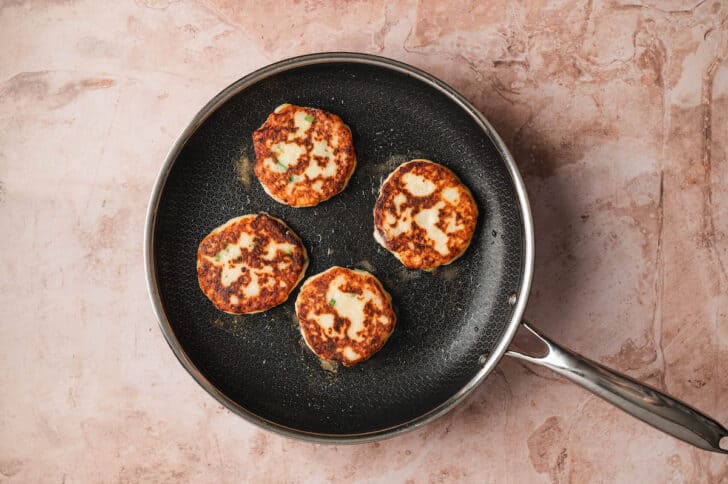
3. GRIDDLE. Cook cakes in a single layer in hot oil in a large nonstick skillet or on a griddle until golden brown on both sides and warmed through. Do this in batches if you need to, keeping the finished cakes warm in a low oven.

4. SERVE. Serve cakes garnished with sour cream and additional chives or green onions, if desired.
Potato Cake Recipe Home Chef Tips
- The potato cake recipe below calls for adding 1/4 cup of flour to the mashed potato mixture (plus another 1/4 cup for dredging the cakes before griddling them). This helps bind the mixture together and form the mixture into patties. However, depending on the consistency of the leftover mashed potatoes you are starting with, you may need a little more or less flour!
- If your leftover mashed potatoes are already very thick, try omitting the flour and seeing if you can form the mixture into patties without it. You may not need flour at all for this mashed potato cakes recipe.
- If your leftover mashed potatoes are on the thinner side (maybe you made them with lots of cream and butter, yum!), you may need a bit more flour. Start with 1/4 cup, and if the mixture is still too thin to form into pancakes (you’re looking for a shaggy consistency sort of like cookie dough), try adding additional flour 1 tablespoon at a time until you achieve the right consistency for these leftover mashed potato cakes.
- You may or may not need to add salt and pepper to taste, depending on how well-seasoned your original mashed potatoes were. If they turned out a bit bland, season them a little more while you’re making the cakes, and be sure to sprinkle them with salt after they are griddled!
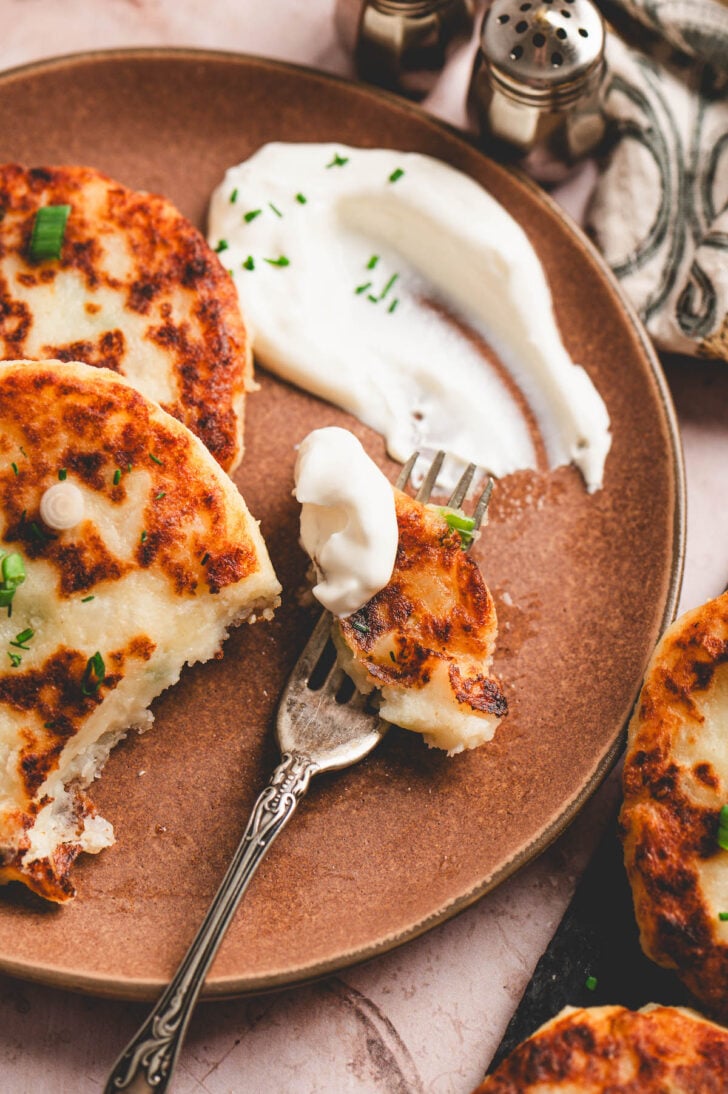
Optional Variations and Mix-Ins
Want to add some pizzazz beyond the chives and Parmesan? Feel free to stir a bit of any of the following into the mixture before griddling:
- extra herbs – thyme, parsley, rosemary or basil
- diced bell pepper or minced jalapeno pepper
- cubed ham or crumbled Oven Bacon
- sundried tomatoes
- chopped pepperoni
How To Serve Potato Pancakes
Potato cakes should be served warm, right after they are griddled. We like to serve these with a dollop of sour cream or Greek yogurt, and an extra sprinkle of chives or green onion. Sometimes, we’ll skip the chives and serve them with applesauce, kind of like you would with latkes. They work great as an appetizer!
You could also serve them drizzled with Gravy From Scratch, with salsa, or with our Sauce For Salmon Patties, which is a sour cream-based sauce with mustard and dill, and good on so much more than just salmon patties!
For breakfast, we like them as a side dish with a simple poached egg and some Sausage Links In Oven.
Our favorite dinner entrees to serve alongside potato cakes include:
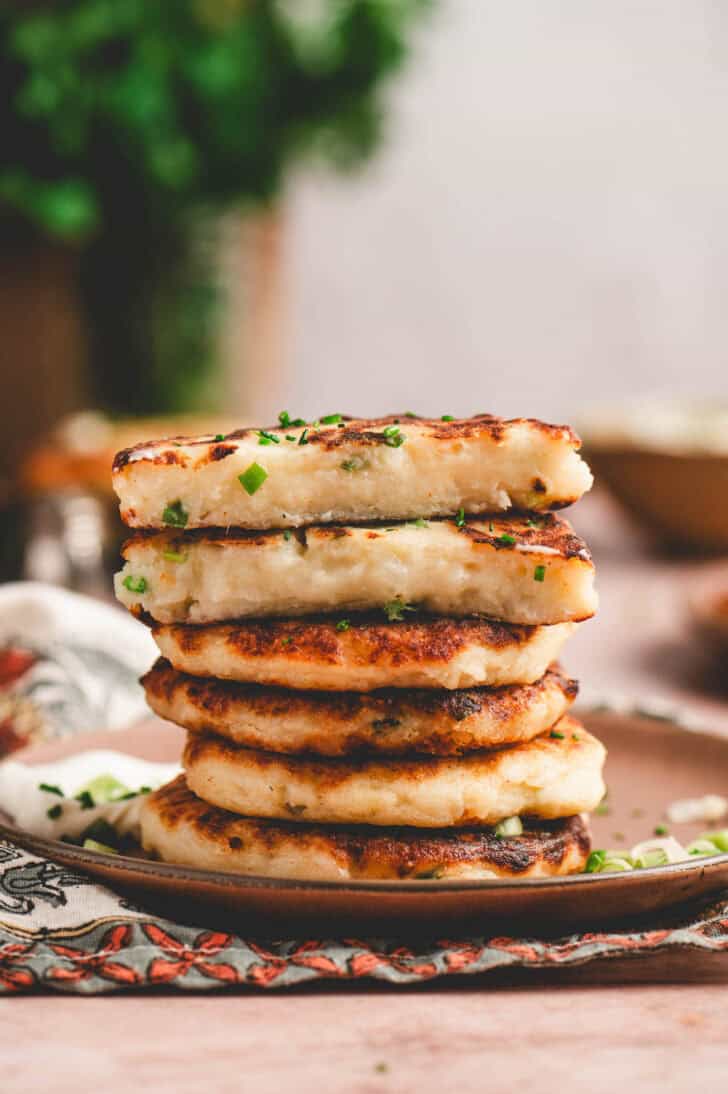
Save This Recipe!
How To Store A Potato Cake
If you have leftovers, transfer them to an airtight container and place them in the fridge uncovered for a few hours until they are fully chilled, then cover them with the lid and keep in the refrigerator up to 2 days.
These potato pancakes also freeze well after they are prepared. Chill them as instructed above, then freeze on a parchment-lined baking pan until frozen. Transfer to a zip-top freezer bag for storage.
Reheat the potato pancakes from frozen in a 350 degree oven until warm.
Recipe For Potato Cakes FAQs
Most importantly, start with mashed potatoes made with Russet or Yukon Gold potatoes, which have a higher starch content, so they hold together better. When cooking your potato cakes, avoid flipping them too soon. Allowing them to brown long enough to create a crust on one side helps them hold together when you flip them.
Soggy potato cakes are usually due to not cooking the cakes long enough, crowding the pan, or not having the pan hot enough. Be sure to cook the potato cakes over medium heat, in batches to give them enough space for proper browning. Cook them 2 to 3 minutes per side or until they have a nice golden brown crust.
The most common culprit of gummy potato cakes is overworking the potato mixture. In Step 1, make sure all of the ingredients are well combined, but be sure not to excessively stir them beyond that. The more you stir them, the more starch will be released from the potatoes, which can result in a gummy texture.
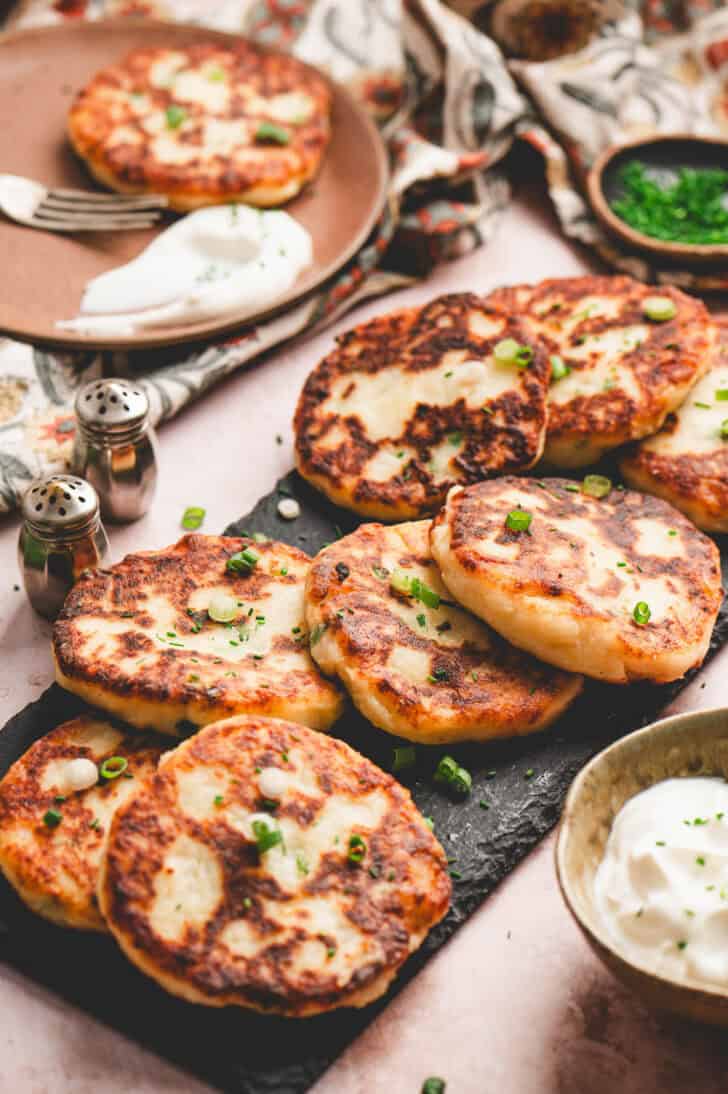
More Foxes Love Lemons Favorites

Potato Cakes from Mashed Potatoes
Save This Recipe!
Ingredients
- 1 large egg
- 3 garlic cloves minced
- 2 cups leftover mashed potatoes chilled
- ½ cup all-purpose flour divided, plus additional if needed (see notes)
- ½ cup grated Parmesan cheese
- 2 tablespoons thinly sliced chives or green onions plus additional for serving (optional)
- 2 tablespoons vegetable oil for frying
- Kosher salt for sprinkling
- 1 cup sour cream for serving (optional)
Instructions
- In large bowl, whisk egg until smooth. Add garlic, potatoes, 1/4 cup flour, cheese and chives. Stir with fork until well combined. Transfer to refrigerator and chill 20 minutes.
- Place remaining 1/4 cup flour on small plate. Divide potato mixture into 8 portions. Using lightly floured hands, shape each portion into a cake about 3 inches across and 1/2-inch thick (it's easiest to form mixture into a ball first and then flatten into a cake). Lightly dredge both sides of each cake in flour.
- Heat oil on large nonstick griddle over medium heat. Transfer cakes to griddle and cook 6 to 8 minutes or until golden brown and warmed through, flipping once halfway through cooking. Sprinkle with salt immediately after griddling. If you don't have a griddle, you can brown the cakes in batches in a large nonstick skillet. Before starting, preheat oven to 200 degrees F, then transfer cooked cakes to rimmed baking pan in oven to keep warm while repeating cooking process with remaining cakes, wiping out pan in between batches.
- Serve cakes warm, garnished with sour cream and additional chives, if desired.
Notes
- The potato cake recipe below calls for adding 1/4 cup of flour to the mashed potato mixture (plus another 1/4 cup for dredging the cakes before griddling them). This helps bind the mixture together and form the mixture into patties. However, depending on the consistency of the leftover mashed potatoes you are starting with, you may need a little more or less flour!
- If your leftover mashed potatoes are already very thick, try omitting the flour and seeing if you can form the mixture into patties without it. You may not need flour at all for this mashed potato cake recipe.
- If your leftover mashed potatoes are on the thinner side (maybe you made them with lots of cream and butter, yum!), you may need a bit more flour. Start with 1/4 cup, and if the mixture is still too thin to form into pancakes (you’re looking for a shaggy consistency sort of like cookie dough), try adding additional flour 1 tablespoon at a time until you achieve the right consistency for these leftover mashed potato cakes.
- You may or may not need to add salt and pepper to taste, depending on how well-seasoned your original mashed potatoes were. If they turned out a bit bland, season them a little more while you’re making the cakes, and be sure to sprinkle them with salt after they are griddled.

